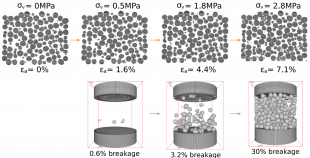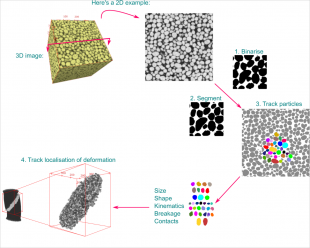Particles exist in great abundance in nature, such as in sands, and also constitute 75% of the materials used in industry (e.g., formulated pharmaceuticals, detergent powders). When a load is applied to a bulk assembly of particles, the macroscopic response originates from changes that take place at the particle scale. If particle breakage occurs, the shape and size of the particles comprising the bulk are changed; this induces changes in the contact network through which applied loads are transmitted, the volumetric behaviour of the material and its permeability. It is therefore unsurprising that the mechanisms leading to particle breakage are a subject of intense research interest in several fields, including geomechanics.
The main aim of this research is to achieve a better understanding of the particle-scale mechanisms that lead to grain breakage. Two materials are used (Caicos ooids and zeolite granules), both subjected to a series of strain-controlled triaxial and oedometric compression tests (Figure 1). This research is focused on investigating how a number of particle parameters, such as shape, size and number of contacts per particle affect breakage, through the use of highresolution (<10 µm/px) X-Ray computed micro-tomography (XCT). Full-field measurements [1] are performed on 3D images, revealing hidden patterns of deformation in the early stages of loading, which contribute to a proper interpretation and understanding of the experimental results. A limitation of image processing is not being able to accurately measure inter-particle forces. The discrete element method (DEM), however, allows us to study changes and observe trends in the transmission of contact forces right before breakage occurs, complementing the XCT results. For the DEM simulations, a Hertz-Mindlin contact model was used to study the changes in the fabric of the specimen right before the majority of breakage occurs, where the model can reproduce the bulk response of the material. This study will enrich our understanding of the mechanisms and evolution of particle breakage.
References
[1]G. Viggiani and S. A. Hall. Full-field measurements, a new tool for laboratory experimental geomechanics. ALERT Doctoral school, 2012.




